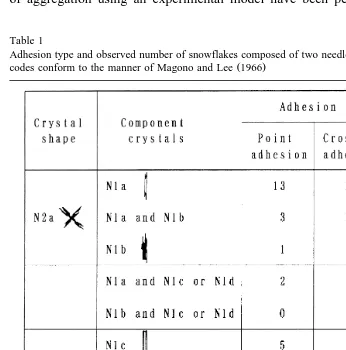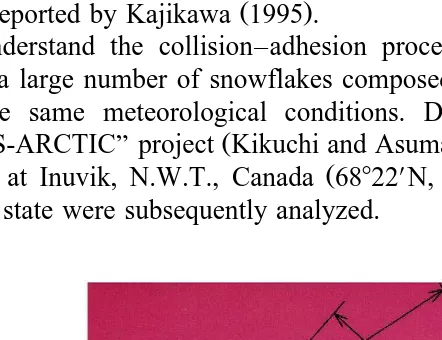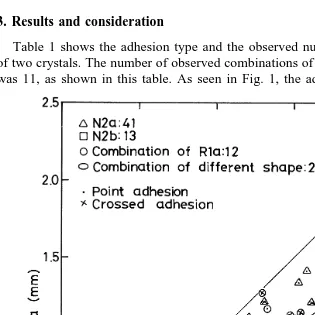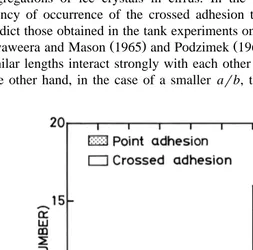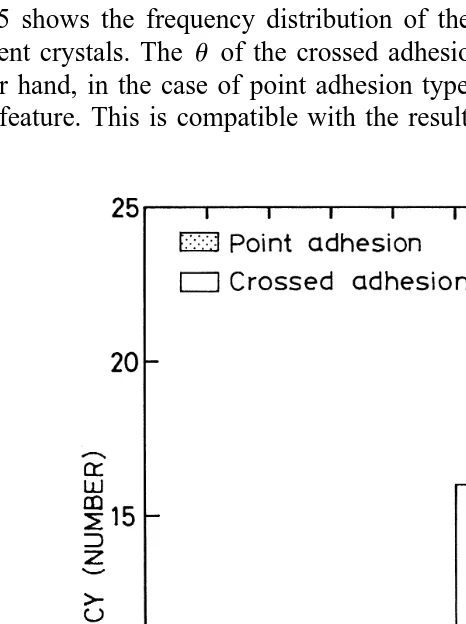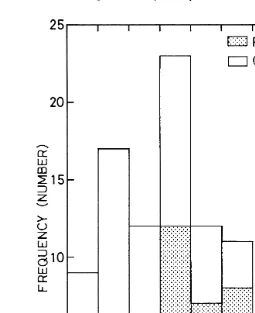www.elsevier.comrlocateratmos
Aggregation of needle snow crystals
Masahiro Kajikawa
a,), Katsuhiro Kikuchi
b,1, Yoshio Asuma
b,
Yusuke Inoue
b,2, Noboru Sato
ca
Department of CiÕil and EnÕironmental Engineering, Faculty of Engineering and Resource Science,
Akita UniÕersity, Akita 010-8502, Japan
b
DiÕision of Earth and Planetary Sciences, Graduate School of Science, Hokkaido UniÕersity,
Sapporo 060-0810, Japan
c
Science Education Institute of Osaka Prefecture, Osaka 558-0011, Japan
Received 13 April 2000; received in revised form 14 June 2000; accepted 13 July 2000
Abstract
For the purpose of studying the early process of snowflake growth, characteristics of the
Ž .
aggregation collision–adhesion process of needle snow crystals were investigated by examining photomicrographs of snowflakes composed of two crystals.
The adhesion type of the snowflakes was classified into crossed adhesion and point adhesion types. When the sizes of the two crystals were similar, which is indicative of nearly equal fall velocity, there was an increased number of the crossed adhesion type, whereas the point adhesion type was predominant when there was a large difference in size, thus fall velocity. In the case of the crossed adhesion type, the angle between the c-axes of the two crystals was usually greater than 708, whereas the angle in the case of the point adhesion type showed no such distinct feature. Our findings suggest that the crossed adhesion type snowflakes are formed mainly through the
Ž .
interaction of the flow fields around two crystals the collision due to relative horizontal motions and the point adhesion snowflakes were formed through the inertial collision between smaller
Ž .
crystals and larger ones the collision due to the velocity difference . q2000 Elsevier Science B.V. All rights reserved.
Keywords: Snowflakes; Aggregation; Needle crystals; Snow crystals
)Corresponding author. Fax:q81-18-889-2653.
Ž .
E-mail address: [email protected] M. Kajikawa .
1
Present affiliation: Akita Prefectural University, Akita 010-0146, Japan.
2
Present affiliation: Japan Weather Association, Tokyo 170-6054, Japan.
0169-8095r00r$ - see front matterq2000 Elsevier Science B.V. All rights reserved.
Ž .
Ž .
Fujiwara 1957 estimated the collision cross-section of needle snow crystals. Studies of aggregation using an experimental model have been performed by Jayaweera and
Table 1
Adhesion type and observed number of snowflakes composed of two needle crystals. Crystal shapes and their
Ž .
Ž .
Fig. 1. Examples of snowflakes composed of two needle crystals. A Point adhesion type composed of two
Ž .
elementary needles. B Crossed adhesion type composed of two elementary sheaths.
Ž . Ž .
Mason 1965 and Podzimek 1968 . In a tank experiment, they observed that two equal
Ž .
cylinders caught up with each other at a right angle crossed state . Takahashi et al.
Ž1992 examined the aggregation of snow crystals using a vertical supercooled cloud.
tunnel. In their study, two columnar crystals usually formed an angle of 70;908. These results do not contradict of the results of analysis of snowflakes composed of two
Ž .
crystals reported by Kajikawa 1995 .
To understand the collision–adhesion process involved in the case of columnar crystals, a large number of snowflakes composed of a few crystals should be observed under the same meteorological conditions. During the observation period of the
Ž .
AWANTS-ARCTICBproject Kikuchi and Asuma, 1999 , many needle snowflakes were
Ž X X
.
collected at Inuvik, N.W.T., Canada 68822 N, 133842 W . The characteristics of the adhesion state were subsequently analyzed.
Ž .
Fig. 2. Factors in the analysis of the characteristics of aggregation Fujiwara, 1957 . d: Distance between the
Ž . Ž .
ŽN1a , elementary sheath N1b , bundle of elementary needles N1c , bundle of elemen-. Ž . Ž .
Ž . Ž . Ž .
tary sheaths N1d and rimed needle crystal R1a Magono and Lee, 1966 .
3. Results and consideration
Table 1 shows the adhesion type and the observed number of snowflakes composed of two crystals. The number of observed combinations of two component needle crystals was 11, as shown in this table. As seen in Fig. 1, the adhesion type of the snowflakes
Ž .
Fig. 3. Relationship between the lengths 2 a and 2 b of two component crystals. The observed number is
Ž .
was divided into two categories, namely, point adhesion and crossed adhesion types
ŽTakahashi et al., 1992; Kajikawa, 1995 ..
In Table 1,AcombinationB refers to the meteorological conditions for growth of two crystals. It can be seen that the combination of similar growth conditions is clearly abundant. The crossed adhesion type is also numerous, as shown in the previous analysis
Ž .
of snowflakes observed on different days Kajikawa, 1995 .
Ž .
Factors indicating the adhesion state of two crystals Fujiwara, 1957 were defined as
Ž
shown in Fig. 2. The letter d is the distance between the centers of larger needle length;
. Ž .
2 b and smaller needle length; 2 a crystals. The angle between the c-axes of two
Ž .
component crystals is taken as u O908.
Ž .
Fig. 3 shows the relationship between the needle lengths 2 b)2 a and shapes of two component crystals, in addition to the adhesion types. The frequency distribution of
Ž .
the needle length ratio arb-1 of two component crystals is shown in Fig. 4. It can be seen from these figures that aggregations are often composed of crystals of like needle
Ž .
lengths. The same phenomenon has been reported by Kajikawa and Heymsfield 1989 in aggregations of ice crystals in cirrus. In the case of larger arb, moreover, the frequency of occurrence of the crossed adhesion type increases. These results do not contradict those obtained in the tank experiments on model columnar crystals performed
Ž . Ž .
by Jayaweera and Mason 1965 and Podzimek 1968 , which have shown that particles of similar lengths interact strongly with each other through relative horizontal motions. On the other hand, in the case of a smaller arb, the frequency of occurrence of point
Ž .
of snow crystals are of equal importance to aerodynamic influences, in particular for
Ž .
crystals of small sizes e.g., Rogers, 1974; Pruppacher and Klett, 1997 . It is difficult, however, to consider the effects from this observation.
Fig. 5 shows the frequency distribution of the angle u between the c-axes of two component crystals. The u of the crossed adhesion type is more frequent near 908. On the other hand, in the case of point adhesion type, the distribution of u shows no such
Ž
distinct feature. This is compatible with the results of previous experiments Jayaweera
Ž .
Ž .
Fig. 6. Frequency distribution of the distance ratio dr2 b between the center of two component crystals.
. Ž
and Mason, 1965; Podzimek, 1968; Takahashi et al., 1992 and analysis Kajikawa,
.
1995 .
Ž .
The frequency distribution of the distance ratio dr2 b between centers of two component crystals is shown in Fig. 6, including the adhesion types. The frequency of occurrence of the point adhesion type increases as dr2 b increases. This suggests inertial collision in which the smaller crystals collide near the edge of larger ones.
4. Concluding remarks
In order to investigate the early process of snowflake growth, characteristics of aggregation of needle snow crystals were analyzed by examining photomicrographs of snowflakes composed of two crystals. The adhesion type of the snowflakes was classified into crossed adhesion and point adhesion types.
Acknowledgements
We wish to express our thanks to the staff members of the Inuvik Science Research Center, N.W.T., Canada for their support and the supply of facilities. This research was financially supported by a Grant-in-Aid for the International Scientific Research
Pro-Ž .
gram Field Research , Project No. 07041077 of the Ministry of Education, Science and Culture of Japan.
References
Fujiwara, M., 1957. Note on collision frequency of snowflakes. J. Meteorol. Soc. Jpn., 75th Anniversary, Vols. 57–64.
Higuchi, K., 1956. A new method for the simultaneous observation of shape and size of a large number of falling snow crystals. J. Meteorol. 13, 274–278.
Higuchi, K., 1960. On the coalescence between plane snow crystals. J. Meteorol. 17, 239–243.
Jayaweera, K.O.L.F., Mason, B.J., 1965. The behavior of freely falling cylinders and cones in a viscous liquid. J. Fluid Mech. 22, 709–720.
Kajikawa, M., 1985. Structure and falling motion of early snowflakes. Ann. Glaciol. 6, 269–271.
Ž
Kajikawa, M., 1995. Characteristics of the aggregation of needle snow crystals. Seppyo. 57, 349–355, in
.
Japanese .
Kajikawa, M., Heymsfield, A.J., 1989. Aggregation of ice crystals in cirrus. J. Atmos. Sci. 46, 3108–3121.
Ž .
Kikuchi, K., Asuma, Y. Eds. , 1999. Studies on the water vapor, aerosols and nuclei transportation and the
Ž .
snow crystals of low temperature types in the Arctic regions WANTS-Arctic . Hokkaido Univ., Japan, 355 pp.
Magono, C., Oguchi, H., 1955. Classification of snow flakes and their structures. Sci. Rep. Yokohama Natl. Univ., Sect. I 4, 47–57.
Magono, C., Lee, C.W., 1966. Meteorological classification of natural snow crystals. J. Fac. Sci., Hokkaido Univ., Ser. VII 2, 321–335.
Nakaya, U., 1954. Snow Crystals, Natural and Artificial. Harvard Univ. Press, 510 pp.
Podzimek, J., 1968. Aerodynamic conditions of ice crystal aggregation. Proc. Int. Conf. Cloud Phys., Toronto, Canada, August 26–30, 1996, pp. 295–299.
Pruppacher, H.R., Klett, J.D., 1997. Microphysics of Clouds and Precipitation. Kluwer Academic Publishing, 954 pp.
Rogers, D.C., 1974, The aggregation of natural ice crystals. Rep. No. AR 110, Dept. Atmos. Resources, Univ. of Wyoming, 35 pp.
Takahashi, T., Endoh, T., Wakahama, G., 1992. Supercooled cloud tunnel studies of aggregation of snow
Ž .
